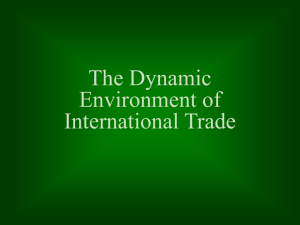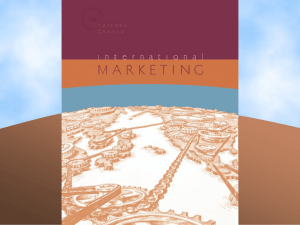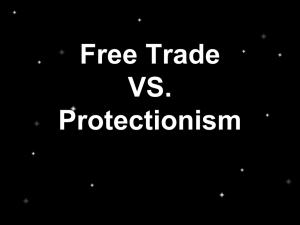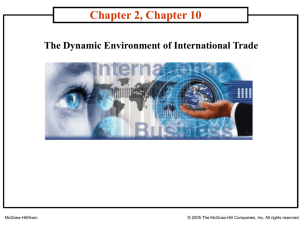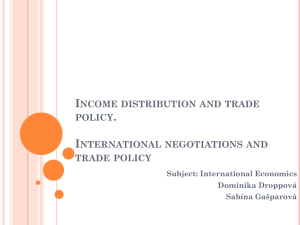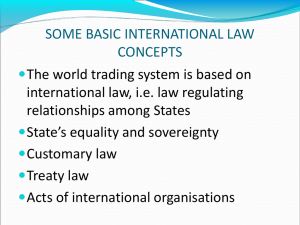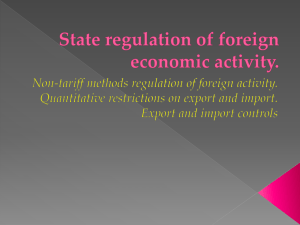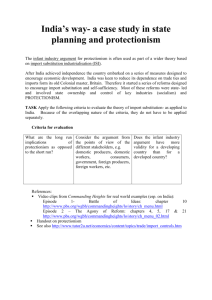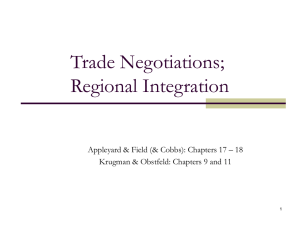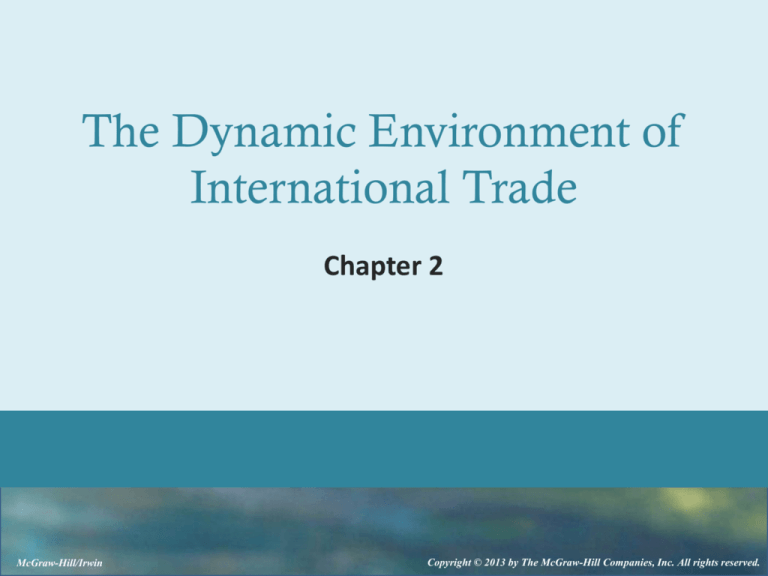
The Dynamic Environment of
International Trade
Chapter 2
McGraw-Hill/Irwin
Copyright © 2013 by The McGraw-Hill Companies, Inc. All rights reserved.
Learning Objectives
LO1
LO2
LO3
LO4
LO5
LO6
LO7
The basis for the reestablishment of world trade
following World War II
The importance of balance-of-payment figures to a
country’s economy
The effects of protectionism on world trade
The several types of trade barriers
The provisions of the Omnibus Trade and
Competitiveness Act
The importance of GATT and the World Trade
Organization
The emergence of the International Monetary Fund
and the World Bank Group
2-2
Trade Barriers
Barriers to trade are one of the major issues
confronting international marketers
They can be tariff or non-tariff barriers
Countries continue to use non-tariff barriers for a
variety of reasons
Tariff barriers have reduced considerably in recent
years
2-3
Exhibit 2.1 Top Ten 2011 U.S. Trading Partners ($ billions, merchandise trade)
2-4
2-5
World Trade and U.S. Multinationals
Dominance of U.S. multinationals in the 1950s and
1960s
Large investments by U.S. companies in Europe and
Latin America
Concern in Latin America resulting in expropriation of
direct U.S. investments
In Europe, there was strong public demand to limit
foreign investment
2-6
Source: Complied from annual reports of listed firms, 2012
2-7
Exhibit 2.3 The Nationality of the World’s 100 Largest Industrial Corporations (size measured by
annual revenues) Source: “2011 Global 500,” Fortune, http://www.fortune.com , 2012.
2-8
Balance of Trade
The balance of merchandise trade also reflected the
changing role of the United States in world trade
Between 1888 and 1971, the United States had a
favorable balance of trade
By 1971, the United States had a trade deficit of $2
billion that grew to at $160 billion in 1987
Trade deficit peaked in 2007, with the continued
weakness in the U.S. dollar
The positive consequence of the global financial crisis in
2008 in the United States was the halving of the U.S.
trade deficit during 2009 from its high in 2007
2-9
Balance of Payments
1.
2.
3.
4.
5.
When countries trade there are financial transactions
among businesses or consumers of different nations
Money constantly flows into and out of a country
The system of accounts that records a nation’s
international financial transactions is called its balance of
payments (BP)
It records all financial transactions between a country’s
firms, and residents, and the rest of the world usually
over a year
The BP is maintained on a double-entry bookkeeping
system
2-10
Balance of Payments
The BP is the difference between receipts and payments
Receipts
• merchandise export sales.
• money spent by foreign
tourists.
• transportation.
• payments of dividends and
interest from FDI abroad.
• new foreign investments in
the U.S.
Payments
• costs of goods imported.
• spending by U.S. tourists
overseas.
• new overseas investments.
• cost of foreign military and
economic aid.
2-11
Balance of Payments
A balance-of-payments statement includes three
accounts
• the current account, a record of all merchandise exports,
imports, and services plus unilateral transfers of funds
• the capital account, a record of direct investment, portfolio
investment, and short-term capital movements to and from
countries; and
• the official reserves account, a record of exports and imports of
gold, increases or decreases in foreign exchange, and increases
or decreases in liabilities to foreign central banks.
Of the three, the current account is of primary interest to
international business.
2-12
Exhibit 2.4 U.S. Current Account by Major Components, 2011 ($ billions)
2-13
Exhibit 2.6 What Would One U.S. Dollar Buy?
Source: The Wall Street Journal, 2012
2-14
Protectionism
The reality of trade is this is a world of tariffs,
quotas, and nontariff barriers and nontariff barriers
designed to protect a country’s markets from foreign
investment
Although the World Trade Organization has been
effective to some extent in reducing tariffs, countries
still resort to measures of protectionism
Countries use legal barriers, exchange barriers, and
psychological barriers to restrict the entry of
unwanted goods
2-15
Arguments for Protectionism
maintain employment and reduce unemployment
increase of business size, and
retaliation and bargaining
protection of the home market
need to keep money at home
encouragement of capital accumulation
2-16
Arguments for Protectionism
maintenance of the standard of living and real wages
conservation of natural resources
protection of an infant industry
industrialization of a low-wage nation
national defense
2-17
The Impact of Tariff (Tax) Barriers
Tariff Barriers tend to increase:
• Inflationary pressures
• Special interests’ privileges
• Government control and political considerations in
economic matters
• The number of tariffs they beget via reciprocity
2-18
The Impact of Tariff (Tax) Barriers
Tariff Barriers tend to weaken:
• Balance-of-payments positions
• Supply-and-demand patterns
• International relations (they can start trade wars)
Tariff Barriers tend to restrict:
• Manufacturer’ supply sources
• Choices available to consumers
• Competition
2-19
Six Types of Non-Tariff Barriers
(1) Specific Limitations on Trade:
• Quotas
• Import Licensing requirements
• Proportion restrictions of foreign to domestic goods (local
content requirements)
• Minimum import price limits
• Embargoes
(2) Customs and Administrative Entry Procedures:
•
•
•
•
•
Valuation systems
Antidumping practices
Tariff classifications
Documentation requirements
Fees
2-20
Six Types of Non-Tariff Barriers
(3) Standards:
• Standard disparities
• Intergovernmental acceptances of testing methods and
standards
• Packaging, labeling, and marking
(4) Government Participation in Trade:
•
•
•
•
Government procurement policies
Export subsidies
Countervailing duties
Domestic assistance programs
2-21
Six Types of Non-Tariff Barriers
(5) Charges on imports:
•
•
•
•
•
•
Prior import deposit subsidies
Administrative fees
Special supplementary duties
Import credit discriminations
Variable levies
Border taxes
(6) Others:
• Voluntary export restraints
• Orderly marketing agreements
2-22
Three Types of Monetary Barriers
Blocked currency: Blockage is accomplished by refusing
to allow importers to exchange its national currency for
the sellers’ currency.
Differential exchange rates: It encourages the
importation of goods the government deems desirable
and discourages importation of goods the government
does not want by adjusting the exchange rate. The
exchange rate for importation of a desirable product is
favorable and vice-versa
Government approval: In countries where there is a
severe shortage of foreign exchange, an exchange permit
to import foreign goods is required from the government
2-23
The Omnibus Trade and
Competitiveness Act (OTCA) 1988
Many countries are allowed to trade freely with the
United States but do not grant equal access to U.S.
products in their countries.
To ease trade restrictions, the OTCA focused on
correcting perceived injustice in trade practices.
It dealt with trade deficits, protectionism, and the
overall fairness of our trading partners.
2-24
The Omnibus Trade and
Competitiveness Act (OTCA) 1988
Covers three areas for improving U.S. trade:
• market access,
• export expansion, and
• import relief
2-25
General Agreement on Tariffs and Trade
(GATT)
Covers three basic areas:
• trade shall be conducted on a nondiscriminatory basis;
• protection shall be afforded domestic industries through
customs tariffs, not through such commercial measures as
import quotas; and
• consultation shall be the primary method used to solve
global trade problems.
2-26
World Trade Organization (WTO)
Unlike GATT, WTO is an institution, not an agreement
It sets many rules governing trade between its 132
members
WTO provides a panel of experts to hear and rule on
trade disputes between members, and, unlike GATT,
issues binding decisions
2-27
WTO
The Internet exposed protected industries to global
competition
WTO was established January 1, 1995 through the
Uruguay round of GATT (1986-1993)
Statutory powers to adjudicate trade disputes
2-28
WTO
Permanent international organization
New legal and institutional foundation
Platform for trade relations: collective debate,
negotiation and adjudication
Dispute settlement faster
Evolution of GATS, TRIMS, TRIPS
2-29
The IMF and the World Bank
The International Monetary Fund (IMF) and the
World Bank Group are two global institutions
created to assist nations in becoming and remaining
economically viable.
These organizations play important roles in
international trade:
• by helping maintain stability in the financial markets and
• by assisting countries that are seeking economic
development and restructuring
2-30
Protests Against Global Institutions
2-31

